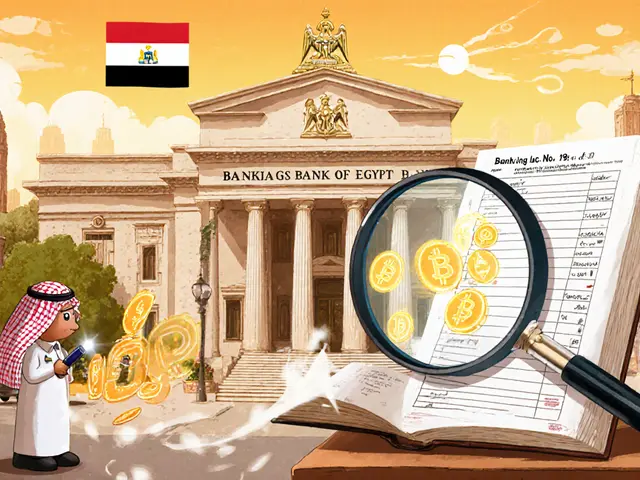Egyptian Crypto Transaction Monitoring Checker
Based on Banking Law No. 194 of 2020, Egyptian banks monitor for:
- Transfers to known exchange wallets
- Patterns of rapid, repeated transfers
- Suspicious behavioral triggers
- Linkages between crypto and traditional channels
Flagged transactions are reviewed and may trigger a Suspicious Activity Report (SAR) to the FRA.
Transaction Analysis Result
Enter transaction details and click "Check for Flags" to see if it would be flagged by Egyptian banks.
Egyptian banks are under a microscope when it comes to crypto. The law says they can’t help customers buy or sell digital coins, yet the demand for Bitcoin, Ethereum and other tokens keeps growing. So banks have built a web of detection tools, reporting lines and compliance teams to stay on the right side of the Central Bank of Egypt (CBE) and the Financial Regulatory Authority (FRA). This guide walks through the legal backdrop, the monitoring tech, the day‑to‑day hurdles, and what’s likely ahead for crypto‑related banking in Egypt.
Legal Landscape Shaping Bank Behaviour
Everything starts with Banking Law No. 194 of 2020, a statute that criminalizes unlicensed cryptocurrency issuance, trading and promotion. Prior to 2020, regulators issued scattered warnings - 2018 was the first public caution, 2019 limited only “unlicensed” trading - but the 2020 law gave banks a concrete compliance target: no crypto services without explicit CBE approval.
The law forces banks to adopt two core duties:
- Implement transaction‑monitoring systems that can flag crypto‑related patterns.
- Report any suspicious activity to the Financial Regulatory Authority (FRA), which acts as the AML/Terrorist‑Financing watchdog.
Non‑compliance can lead to criminal penalties, license suspension, or even imprisonment for senior compliance officers.
The Central Bank’s Role and Recent Alerts
The Central Bank of Egypt (CBE) is the linchpin. Its March82023 circular reminded the public that crypto transactions are “unlicensed” and carry high risk. The latest May122025 FRA warning zeroed in on aggressive online ads promising huge crypto returns, labeling them a conduit for money‑laundering and terrorist financing.
Each warning tightens the net: banks must now scrutinise not only direct transfers to known exchange wallets but also indirect pathways - peer‑to‑peer platforms, crypto‑linked payment processors, and even seemingly benign fiat‑to‑fiat remittances that end up on exchange platforms.
What Banks Must Monitor
Monitoring isn’t just about looking for the word “Bitcoin” in a transaction description. Banks use a combination of data points:
- Destination analysis: IP‑based geolocation, wallet address clustering, and known exchange identifiers (e.g., Binance, Bitget, Rain).
- Pattern detection: Rapid, repeated transfers of similar amounts to multiple exchange wallets - a classic “smurfing” tactic.
- Behavioural triggers: New customers suddenly sending large outbound wires after a period of inactivity.
- Channel cross‑checks: Linking mobile‑money top‑ups, online bill‑pay services, and card‑based purchases that could fund crypto purchases.
When any of these flags fire, the transaction is held, the customer is contacted for additional justification, and a Suspicious Activity Report (SAR) is filed with the FRA.
Technology Stack Behind the Scenes
Most Egyptian banks rely on a mix of in‑house rule‑based engines and third‑party AML platforms. The typical stack includes:
- Core banking data lake: Real‑time transaction feed stored in a secure Hadoop or Snowflake environment.
- Rule engine: Custom scripts that match transaction attributes against a list of flagged crypto exchange addresses (updated monthly).
- Machine‑learning models: Supervised classifiers trained on historic flagged cases to spot emerging evasion techniques.
- Case management system: Workflow tools that route alerts to compliance analysts, track SARs, and log audit trails.
Vendors such as FICO, Nice Actimize, and local fintech firms provide the AI modules, while banks handle the rule maintenance and regulatory reporting.
Implementation Timeline and Resource Allocation
Deploying a fully‑functional monitoring solution takes 6‑12months, depending on the bank’s existing IT foundation. The rollout typically follows these phases:
- Gap analysis - mapping current AML controls against the crypto‑monitoring checklist derived from Law194.
- Data integration - linking wire, ACH, SWIFT, and card feeds into a unified analytics platform.
- Rule and model configuration - loading exchange address lists, setting threshold values, and training ML models.
- Pilot testing - running the system on historical data to fine‑tune false‑positive rates.
- Full‑scale launch - real‑time monitoring goes live, accompanied by staff training and internal audit validation.
Human resources are equally critical. Larger banks have dedicated crypto‑monitoring units of 5‑10 analysts, while midsize institutions often assign a few senior AML officers to the task. Continuous education is a must because crypto developers constantly change wallet structures and transaction formats.
Best‑Practice Checklist for Compliance Teams
| Action | Why It Matters | Typical Frequency |
|---|---|---|
| Update exchange address list | New exchanges appear, old ones change wallets | Monthly |
| Run SAR audit | Ensure reports meet FRA standards | Quarterly |
| Conduct staff drills | Prepare analysts for high‑volume alert bursts | Bi‑annually |
| Review ML model performance | Reduce false positives and catch new patterns | Every 3months |
| Engage external legal counsel | Interpret new CBE directives quickly | As needed |
Following this checklist helps banks stay compliant without choking legitimate international payments.

Challenges on the Ground
Even with sophisticated tools, banks face real hurdles:
- Data privacy constraints: Egyptian data‑protection laws limit how much transaction metadata can be stored for long periods.
- Cross‑border opacity: Many users route money through offshore wallets, making true ownership hard to verify.
- Customer friction: Over‑zealous monitoring leads to rejected transfers, prompting complaints and potential churn.
- Resource strain: Smaller banks lack the budget for advanced AI, relying on manual rule‑sets that generate more false alerts.
These pain points force banks to balance risk mitigation with service quality - a delicate act in a market where crypto interest remains high despite the bans.
Future Outlook: Toward More Stringent Oversight?
Two trends loom large:
- Regulatory tightening: The FRA’s May2025 warning suggests a new wave of enforcement actions. Expect more granular reporting requirements, possibly mandatory blockchain‑analytics provider contracts.
- Regional divergence: Gulf neighbours are piloting regulated crypto sandboxes and CBDCs. Egypt’s conservative stance may shift if capital flight intensifies, but for now the policy focus stays on preventing money‑laundering and terrorist financing.
Banks that have already invested in flexible monitoring architectures will adapt faster. Those lagging may face heavier audits, higher fines, or even license revocation.
Key Takeaways
- Banking Law No.1942020 makes unlicensed crypto activity a criminal offence for banks.
- The CBE and FRA issue periodic alerts that expand monitoring scope.
- Effective detection hinges on destination analysis, pattern recognition, and AI‑enhanced models.
- Implementation typically requires 6‑12months and dedicated compliance talent.
- Staying ahead means constant address updates, regular SAR audits, and close liaison with legal counsel.
In short, Egyptian banks are building a layered defence against crypto transactions, and cryptocurrency transaction monitoring has become a daily reality for compliance officers across the country.
Frequently Asked Questions
Is it illegal for an Egyptian citizen to own cryptocurrency?
Ownership itself isn’t criminalised, but any buying, selling or promotion without a CBE licence is prohibited. Holding crypto acquired abroad can attract scrutiny if you move funds through local banks.
What types of transactions do banks flag as crypto‑related?
Transfers to wallets linked to known exchanges, rapid multiple outbound wires of similar size, and any payment that mentions crypto‑keywords in the memo field are typical triggers.
How long does a bank keep records of flagged transactions?
Under Egyptian AML rules, banks must retain transaction logs for at least five years, and SAR documentation for the same period, unless a court orders earlier deletion.
Can a bank reject a legitimate international transfer because of crypto monitoring?
Yes, if the monitoring system flags the transfer as high‑risk. Banks are required to request additional justification and may hold the funds until the customer provides supporting documents.
What should I do if my transfer is frozen due to suspected crypto activity?
Contact the bank’s compliance desk promptly, explain the purpose of the transfer, and be ready to share receipts or invoices that prove a non‑crypto use. Cooperation usually speeds up the release.







Petrina Baldwin
October 10, 2025 AT 02:45This is wild. My cousin in Cairo just got his account frozen because he sent $500 to pay for a VPN. No crypto involved. Banks are overreacting hard.
They treat every wire like it's a Bitcoin dump.
It's not compliance-it's paranoia.
Ralph Nicolay
October 11, 2025 AT 01:00While the regulatory framework outlined in Banking Law No. 194 of 2020 is unequivocally stringent, the operational implementation by Egyptian financial institutions necessitates a nuanced approach to compliance. The integration of machine learning models with rule-based engines, while technically sophisticated, may inadvertently introduce systemic false positives that undermine customer trust and operational efficiency. A rigorous cost-benefit analysis, aligned with international AML benchmarks, is warranted to ensure proportionality and regulatory efficacy.
sundar M
October 11, 2025 AT 14:46Brooooooo, this is actually insane in the best way! 🤯 I work in fintech back home in Bangalore and we're watching Egypt like a Netflix doc-this is the future of AML, but with more stress and less coffee.
Big up to the compliance teams doing this with half the budget and twice the pressure. That ‘update exchange address list monthly’? That’s a full-time job in itself.
I’ve seen P2P wallets morph faster than TikTok trends. One week it’s Binance, next week it’s some Telegram bot with a .xyz domain. How are they keeping up?!
Also, the part about ‘seemingly benign remittances’ ending up on exchanges? YES. My uncle sent money to his cousin in Sudan for ‘food’-turns out it went to a crypto mixer. No one knew. Not even the bank.
Why isn’t this being taught in every AML course? This is gold. Someone make a YouTube series on this.
And hey, if any Egyptian bank needs help training their ML models, I’ve got a buddy who’ll do it for pizza. No cap.
Nick Carey
October 12, 2025 AT 08:09So let me get this straight-banks are spending millions to catch people buying crypto… but everyone’s just using Telegram bots and cash-in-hand deals anyway?
Who’s really getting caught here? The guy who sent $200 to Binance? Or the guy who’s laundering millions through a fake import/export business?
Feels like fighting a fire with a squirt gun while the whole building’s on fire.
Sonu Singh
October 12, 2025 AT 09:02hey guys i just read this and wow its so detailed! i work in a small bank in delhi and we have same prob but no real ai tools. we just flag anything with 'btc' or 'eth' in memo and call it a day 😅
we miss like 80% of real crypto flows because we dont have the wallet lists updated. last month someone sent money to 'rain.com' and we thought it was a rainwater harvesting startup lol
also the 5 year record rule? we barely keep 6 months. hope the fba doesnt audit us 😬
ps: if anyone has a free updated list of egyptian crypto wallets pls dm me!!
Peter Schwalm
October 13, 2025 AT 02:07Great breakdown. Really appreciate how you mapped the tech stack and implementation phases-it’s rare to see this level of operational detail in regulatory content.
One thing I’d add: the human element is the weakest link. Even the best AI can’t replace an analyst who’s seen 500 SARs and knows when something feels ‘off’ but doesn’t trigger a rule.
Smaller banks need mentorship programs, not just software. Pair junior analysts with veterans who’ve handled the first wave of crypto alerts. Build institutional memory.
Also, the ‘customer friction’ point? That’s the real battleground. If your bank becomes known for freezing transfers randomly, people will find other ways to move money-offshore, crypto ATMs, hawala networks. Compliance isn’t just about blocking-it’s about steering.
And yes, update those wallet lists monthly. I’ve seen banks get burned because they used a list from 2023 and missed three new decentralized exchanges that launched in Q1 2025.
Keep doing this work. The system’s broken, but you’re the ones trying to fix it with one hand tied behind your back.